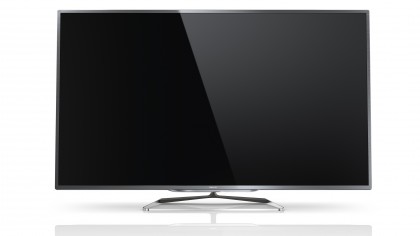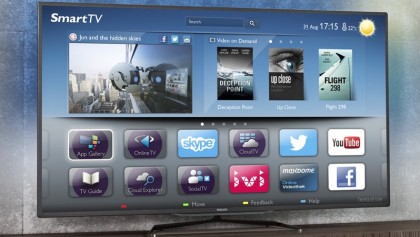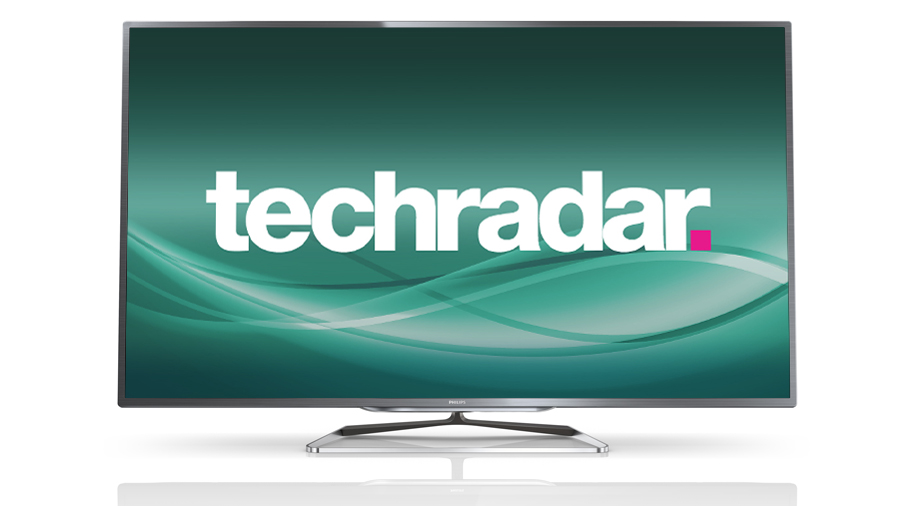TechRadar Verdict
So long as you're not afraid to put in a bit of regular picture set-up leg work it's also capable of excellent picture quality, and can accompany these pictures with a superior soundstage. It's fair to say the 4K price war starts here.
Pros
- +
Mostly excellent picture quality
- +
Ground-breaking price
- +
Effective Ambilight configuration
- +
Good audio
Cons
- -
Set up requires extreme care
- -
Processing can be over-ambitious
- -
Limited viewing angle
- -
Limited online content
Why you can trust TechRadar
Philips isn't generally associated with aggressive value - at least when you're talking about the upper reaches of its TV range.
But in a startlingly bold move the brand is selling its first 4K/UHD TV - the 65PLF9708S - for a price that undercuts all of its 65-inch 4K/UHD TV rivals.
And not just by a pound or two, either; it's £500 cheaper than the Sony KDL-65X9005A and Samsung UE65F9000 (read the 55-inch review here) 4K TVs, and a whole grand cheaper than the Panasonic L65WT600, Toshiba 65L9363 and LG 65LA970W.
That we're seeing such price differentiation so early in 4K's life bodes well for the format becoming 'mainstream' sooner rather than later. However, it also raises concerns that Philips has had to serve up a fairly stripped-back TV to make the 65PFL9708S's price achievable.
Thankfully, these concerns prove unfounded, as its 4K native resolution is actually backed up by many eye-catching tricks and treats including Philips' Ambilight technology, a new mega-powerful 'Ultra Pixel HD' picture processing system, 3D playback, and smart features that include both file streaming from DLNA PCs and access to an open web browser and Philips' own ring-fenced area of online content.
The 65PFL9708S is currently Philips' only 4K TV option. So if you want a Philips TV but can't afford this model's £4.5k asking price, your highest quality 'mainstream' option in the UK would be the PFL8008 series (available in 55-inch, 46-inch and 40-inch screen sizes), which currently rank as some of the best-quality HD TVs available thanks to their beautifully rich, high-contrast pictures.
We've already mentioned the 65PFL9708S's UHD competition if you're not stuck on its ground-breaking price tag or the Philips brand. So without further ado let's find out if that price comes with any significant strings attached.
Sign up for breaking news, reviews, opinion, top tech deals, and more.
Features
Obviously the headline feature of the 65PFL9708S is the carriage in its 65-inch screen of 3840x2160 pixels rather than the 1920x1080 you find in a normal HD TV.
This relatively new '4K' or UHD (Ultra High Definition) configuration delivers four times as much resolution as the traditional full HD pixel system, and has already proved that it can deliver deliriously good picture quality with native 4K sources.
With this in mind it's a tad inconvenient that native 4K sources are currently pretty much non-existent. For our tests, aside from our 4K digital photographs, we're still predominantly dependent on 4K demo reels from the TV manufacturers for 4K content. And the latter of these sources will not be available to normal consumers.
Still, we're confident that 4K content will start to emerge in 2014, and potentially in quite decent quantities by the end of that year. So buying a 4K TV now needn't require you to play quite such a waiting game as you might think before you can unlock its full potential.

Given that the 65PFL9708S is the cheapest 65-inch 4K TV to date by quite some margin, you could reasonably argue that its £4,500 price is a key 'feature' of the TV. It will be interesting to see if any of the other big brands try to compete with this price soon, though our suspicion is that they won't - until their next 4K TV generation, at any rate…
Philips has hit a strong note with most of its TV designs for 2013, so the slightly bland deep grey/black rectangle around the 65PFL9708's screen comes as something of a surprise. Fortunately, the design springs into life when you switch it on thanks to the riot of coloured light that suddenly explodes from its left, right and top edges.
This is, of course, Philips' unique Ambilight technology in action, using LEDs ranged down the TV's rear sides to produce a colourful aura around the TV's edges that can be set to match with striking accuracy (in terms of colour location and tone) the colour content of the pictures you're watching.
If you're a grumpy conservative type thinking this all sounds a bit vulgar, there is some science behind it, as providing such a light aura beyond the image can relieve stress on your eyes, especially during dark-room viewing. We'd also say Ambilight can increase your immersion in what you're watching - so long, at any rate, as you adjust its settings to reduce its brightness and aggressiveness from the default levels.
The 65PFL9708S's connectivity is impressive. Particularly eye-catching is its roster of five HDMIs - one of which is designated specifically for 4K use since it attaches to a dedicated chipset which is specially optimised to handle the extra data demands associated with 4K.
The special 4K/UHD input is not, though, built to the new HDMI 2.0 specification. So, unlike the true HDMI 2.0 inputs on Panasonic's L65WT600, none of the HDMIs on the 65PFL9708S can currently handle 4K/UHD at more than 30 frames a second.
However, Philips assures us that it will deliver an external box solution that WILL make 4K at 50/60Hz possible. We just don't know yet when this box will appear, how much it will cost, or exactly how it will work!
The 65PFL9708S's connections also take multimedia duties suitably seriously, with three USBs able to play back a good variety of video, music and photo files from USB storage devices, and LAN/Wi-Fi options for streaming the same range of files from DLNA-enabled PCs - or accessing Philips' online services.
These online services include Skype and a web browser, as well as a roster of apps within Philips' ring-fenced online area. However, these apps are sadly not very numerous, especially when it comes to that most important of online TV content, video streaming.
You get the BBC iPlayer, Netflix, YouTube and iConcerts, plus a startling array of adult channels including Brazzers and Hustler. But at the risk of sounding prudish, we'd happily trade the smut for the ITV Player, 4OD, Demand 5, and LoveFilm to name but four.
All-in-all, there's just no hiding from the fact that Philips' Smart TV offering is currently some way off the pace being set in this area by some of its rivals.

As well as providing a dedicated input for 4K/UHD sources, the 65PFL9708S comes bearing a new video processing system specially designed for handling the extreme demands of 4K/UHD resolutions.
Dubbed Ultra Pixel HD, Philips' new processing system is powerful enough to handle a brain-boggling four billion pixels at a time - enough to allow Philips to be able to apply its Perfect Natural Motion processing to 4K/UHD content; allegedly boost the sharpness of even native UHD content via an Ultra Resolution option; and upscale more effectively standard- and high-definition content to the screen's 4K resolution. This latter functionality will be particularly important in the short term, until native 4K sources become widespread.
We've already seen an array of different panel types used on 4K TVs (though tellingly, no plasmas, aside from Panasonic's impossibly huge 152-inch model from 2010). So let's take a look at what lies behind the 65PFL9708S's 65-inch screen, too.
It turns out that it uses an edge LED lighting system, and seeks to optimise the way this light is applied to its pictures via a high-level micro-dimming system that breaks the image content down into many smaller areas for more accurate analysis.
Philips does not employ a local dimming system in its edge LED lighting array like Samsung, Sony and Panasonic all do with their edge LED 4K/UHD TVs.
But part of Philips' processing has been designed to be able to manipulate the image to give the impression of local contrast 'boosts'. Plus, we've seen micro-dimming without local dimming deliver excellent contrast results elsewhere this year, such as on the Samsung F8000 models, and Philips' own PFL8008s.
The 65PFL9708S supports 3D playback using the passive system, with four pairs of glasses included free.
Passive 3D really comes into its own with 4K screens in our opinion, for the extra pixels on offer mean you can see a true full HD 3D Blu-ray image rather than the compromised resolution the passive format gives on normal HD TVs. This full HD resolution is accompanied, of course, by the familiar passive 3D benefits of no flicker and practically no crosstalk (so long as you keep your vertical viewing angle within around 13 degrees above or below the screen).
Of course, you don't get full 4K 3D resolution like you can with active 3D 4K TVs (essentially Samsung's F9000 models). But given the amounts of data involved, we're really not sure when native 4K 3D sources might come on line. At the moment Samsung's TVs have to upscale HD 3D to their 4K pixel counts.

John has been writing about home entertainment technology for more than two decades - an especially impressive feat considering he still claims to only be 35 years old (yeah, right). In that time he’s reviewed hundreds if not thousands of TVs, projectors and speakers, and spent frankly far too long sitting by himself in a dark room.
